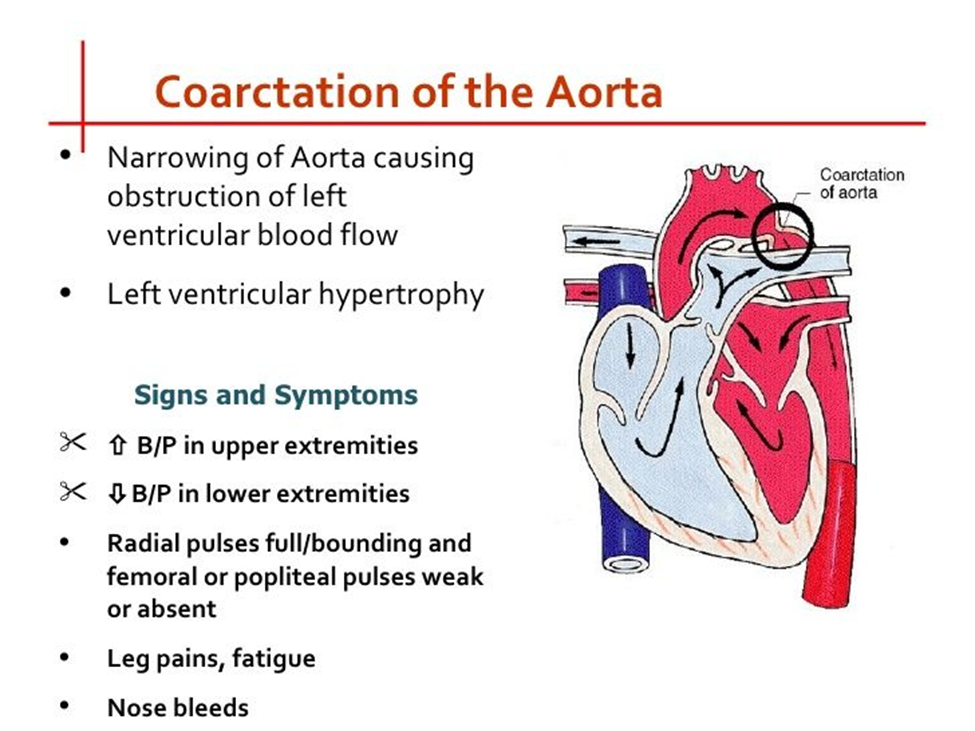A nurse is collecting data from an infant who has coarctation of the aorta. Which of the following manifestations should the nurse expect?
Machine-like murmur
Severe cyanosis
Decreased blood pressure in the legs
Pulmonary edema
The Correct Answer is C
A. Machine-like murmur:
A machine-like murmur typically refers to a continuous murmur, which can be heard throughout systole and diastole. While machine-like murmurs can be associated with certain cardiac conditions, such as patent ductus arteriosus (PDA), they are not typically heard in coarctation of the aorta. In coarctation of the aorta, a systolic ejection murmur may be heard over the upper left sternal border due to turbulent blood flow across the narrowed aortic segment.
B. Severe cyanosis:
Cyanosis refers to a bluish discoloration of the skin and mucous membranes due to decreased oxygenation of the blood. While cyanosis can occur in various congenital heart defects, such as tetralogy of Fallot, it is not a characteristic manifestation of coarctation of the aorta. Coarctation of the aorta typically results in decreased blood flow to the lower extremities rather than mixing of oxygenated and deoxygenated blood.
C. Decreased blood pressure in the legs:
This is the correct choice. Coarctation of the aorta is characterized by narrowing of the aorta, which leads to decreased blood flow to the lower extremities. Consequently, blood pressure measurements in the legs may be lower compared to those in the arms. This finding is often a key indicator of coarctation of the aorta.
D. Pulmonary edema:
Pulmonary edema refers to the accumulation of fluid in the lungs and is typically associated with conditions such as heart failure or fluid overload. While some congenital heart defects may lead to heart failure and subsequent pulmonary edema, coarctation of the aorta does not directly cause pulmonary edema. Instead, it primarily affects blood flow to the lower extremities due to the narrowing of the aorta.

Nursing Test Bank
Naxlex Comprehensive Predictor Exams
Related Questions
Correct Answer is D
Explanation
A. "I will use powders & lotion on his skin around the harness clasps."
This statement indicates a misunderstanding. Powders and lotions should generally be avoided around the harness clasps because they can interfere with the proper fit of the harness and cause irritation or discomfort to the baby's skin.
B. “I will remove the harness daily, prior to giving the bath.”
This statement is incorrect. The Pavlik harness is typically not removed for bathing, as it needs to be worn continuously to maintain proper positioning of the hips and promote optimal healing. Removing the harness daily for bathing can disrupt the treatment process and delay progress.
C. "I will adjust the harness straps every day."
This statement indicates a misunderstanding. The harness should not be adjusted daily without guidance from the healthcare provider. The straps of the Pavlik harness are initially adjusted by the healthcare provider to ensure proper fit, and they should remain in place without frequent adjustments to maintain stability and effectiveness.
D. "I will check my baby's skin under the straps frequently."
This statement indicates an understanding of the teaching. It is essential for the mother to regularly check her baby's skin under the harness straps for any signs of irritation, redness, or pressure sores. Monitoring the skin closely allows for early detection of any issues that may arise from wearing the harness.

Correct Answer is D
Explanation
A. Restrain the toddler for 1 hr after the procedure:
This choice involves restraining the toddler for a period of time after the lumbar puncture procedure. However, restraining a toddler for such a prolonged period is not typically necessary and may cause distress and discomfort to the child. Moreover, prolonged restraint is not recommended as it can hinder the child's mobility and may lead to emotional distress.
B. Swaddle the toddler in a warm blanket:
Swaddling a toddler in a warm blanket may provide comfort, but it is not directly relevant to the lumbar puncture procedure itself. While comfort measures are important for overall patient care, they should not replace or interfere with the specific positioning requirements for medical procedures like a lumbar puncture.
C. Ask another nurse to assist with holding the toddler in a prone position:
This choice involves having another nurse assist in holding the toddler in a prone (face-down) position during the lumbar puncture procedure. However, the prone position is not typically used for lumbar punctures in toddlers. Placing the toddler in a prone position might make the procedure more challenging and less safe for both the child and the healthcare provider.
D. Place the toddler in a side-lying knee-chest position:
Placing the toddler in a side-lying knee-chest position is the correct action for a lumbar puncture procedure in a toddler. This position maximizes the space between the vertebrae, making it easier for the healthcare provider to access the lumbar area safely and accurately. It also helps minimize the risk of injury and discomfort for the toddler during the procedure. Therefore, this choice is the most appropriate for ensuring the success and safety of the lumbar puncture procedure.
Whether you are a student looking to ace your exams or a practicing nurse seeking to enhance your expertise , our nursing education contents will empower you with the confidence and competence to make a difference in the lives of patients and become a respected leader in the healthcare field.
Visit Naxlex, invest in your future and unlock endless possibilities with our unparalleled nursing education contents today
Report Wrong Answer on the Current Question
Do you disagree with the answer? If yes, what is your expected answer? Explain.
Kindly be descriptive with the issue you are facing.
